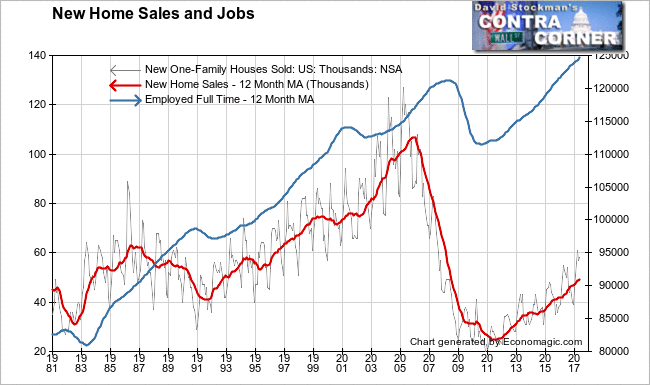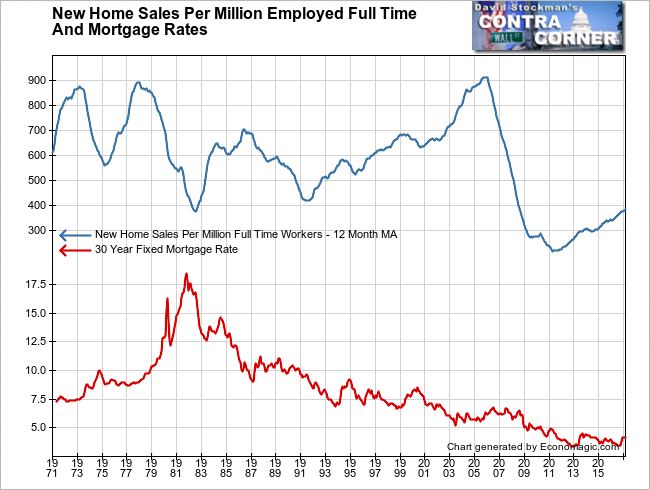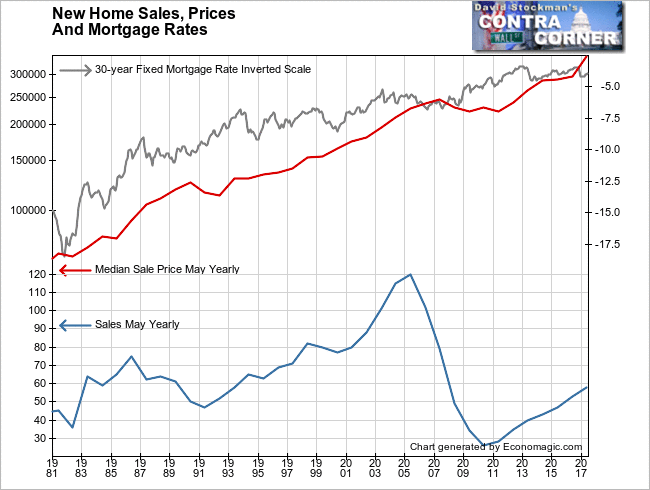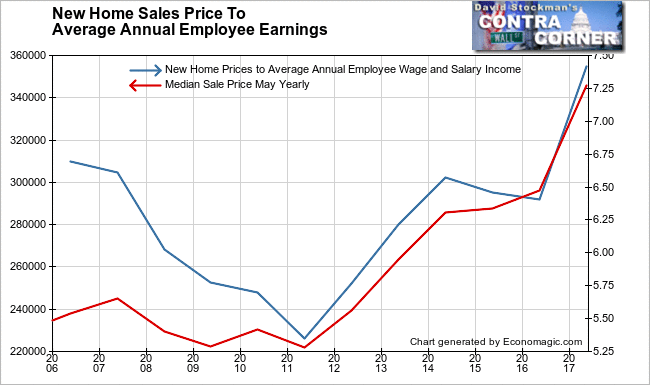Last week we looked at new home sales volume data and saw a rise in sales and even bigger rise in prices as buyers panic to get in before mortgage rates rise and home prices rise even more. Such panicked buyers, not to mention panicked news media, are signs of an end stage mania.
The buying is delusional because it disregards the facts. The most important of those facts is that prices won’t continue to rise when mortgage rates rise. The mortgage subsidy stopped increasing nearly 5 years ago. Soon that subsidy will begin to be reduced when the Fed promotes a rise in mortgage rates.
Buyers are already stretched to the limits of qualification. Lenders are rushing close deals that under normal underwriting standards would never close. This behavior is exhausting a shrinking pool of qualified buyers. The widely touted apparent inventory shortage today will turn into a glut tomorrow when mortgage rates rise.
And mortgage rates are all but certain to rise when Congress raises the debt limit, and when the Fed begins to shrink its balance sheet. Both actions will cause Treasury supply to increase. The increase in supply will pressure bond prices lower and thus yields higher. Mortgage rates are joined at the hip with bond yields. Mortgage rates will rise. An increasing number of would be homebuyers will find themselves unable to qualify for the mortgage needed to purchase a house at current prices.
As prices and mortgage rates rise, sales volume will crater. Builders and home sellers will be forced to lower their prices. The rout will be on. Late stage buyers will rue the day they bought their houses as they soon find themselves under water, their equity gone. Just like 2008, they will owe more on their mortgages than their houses are worth. The jingle mail phenomenon that we saw in 2008 and 2009 won’t be far behind, as many homeowners mail in their keys to their lender.
This is a worst case scenario of course. It’s hard to see the Fed letting things get that far without reversing course, but it remains to be seen what will happen when they do. That’s over the horizon. What I’m concerned about here is looking toward the horizon. There are storms ahead. The best way to weather them will be to avoid the housing market, housing stocks, REITs, and Financials until they pass. That could be a long time. The next crisis won’t be able to be papered over as easily as the last one was. The Fed has less ammo on the rate size, and the market will be more skeptical of the Fed’s magical powers to materialize money.
Looking at the data from where we left off the other day, we saw how the recent recovery in home sales has failed to keep pace with population growth. Population adjusted sales are near all time lows. It’s the same story relative to jobs. The media keeps touting strong housing demand because of the increasing number of jobs. In reality sales are extremely weak relative to historical norms. The new jobs being created simply don’t pay enough to provide for the purchase of a home.
Historically, new home sales correlated closely with jobs growth. Growth rates in the 2 series correlated closely from 1992 until 2006. That relationship began to break as home sales collapsed in 2006 and it got worse throughout the housing crash. When the recovery began in 2009, the number of new full time jobs bottomed, but new home sales kept falling, not hitting bottom until 2011. Since then the gap has never closed. In fact, jobs growth is outpacing home sales. The gap is widening.

That shows that while there may be lots of new jobs being created, housing inflation is increasing so fast it is far surpassing the gains in pay for new jobs. Much of the shrinking US middle class can no longer afford to purchase a home. Sales per million workers today have barely reached the level of the bottom of the 1982 recession when mortgage rates were 18%! Today, rates are at 4.25% and buyers can barely qualify for the mortgage needed to purchase at today’s prices. What will happen now when rates start rising? This trend will only grow worse.

In fact, it would grow dramatically worse. Falling mortgage rates have been the primary driver of long term housing inflation. While the word inflation is never used in conjunction with housing prices, in fact housing may represent one of the purest representations of monetary inflation and falling interest rates. It is inexcusable that home prices are not included in any official inflation measure. Inflation has overheated and policy makers don’t see it. Consumers do, especially when they’re trying to buy a home.
This trickery is what enables the establishment to proclaim that general inflation is too low. It’s a joke. Housing inflation is too high, and is even accelerating. Year to year the median price of new homes sold rose by 16% in May. That’s just absurd. The 12 month moving average of housing inflation is 6%, near the inflation rate of existing homes. Meanwhile, worker pay is rising 2-2.5%.
This chart shows the long term trend of prices, along with mortgage rates on an inverse scale. It graphically illustrates the correlation between falling mortgage rates and the price trend. But mortgage rates stopped falling more than 4 years ago, while prices have continued to inflate. That inflation accelerated this year. This isn’t confined to new homes. Recent data from Corelogic and Redfin showed a rise in the inflation rate on existing homes also.

Falling rates meant that the buyer subsidy was constantly increasing, with but minor interruptions from 1981 until the end of 2012. That subsidy stopped increasing then. But housing inflation has raged on. Buyers are no longer seeing the interest portion of mortgage payments shrinking. Instead, they are voluntarily bidding up the principal portion of their payments to the limits that they can afford. The market is well beyond the level of price to household labor earnings reached at the top of the Great Housing Bubble.

If buyers continue to bid up prices, demand will rapidly shrink as fewer and fewer buyers qualify for a mortgage at then current price levels. Volume goeth before the fall. That’s what happened in the Great Housing Bubble. Sales volume peaked in 2006. Prices didn’t roll over until more than a year later. The crash followed in short order. I see the same process developing today. Inflation ultimately leads to its own demise as fewer and fewer buyers can afford to buy.
Asset inflation is far more dangerous than consumer inflation because it is driven and backed by debt, in this case trillions and trillions of debt. When collateral values fall below the notional value of the debt the result is financial crisis. This has put the Fed in a Catch 22. It will tighten credit at the extreme risk of triggering a crash. But the Fed always believes that it can manage a soft landing. As usual, it will probably be proven wrong.


